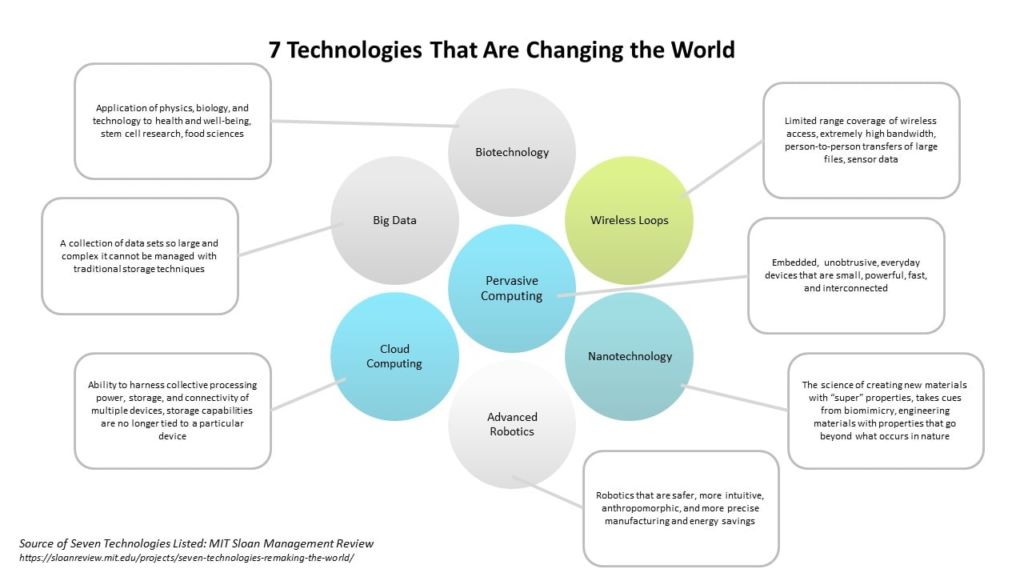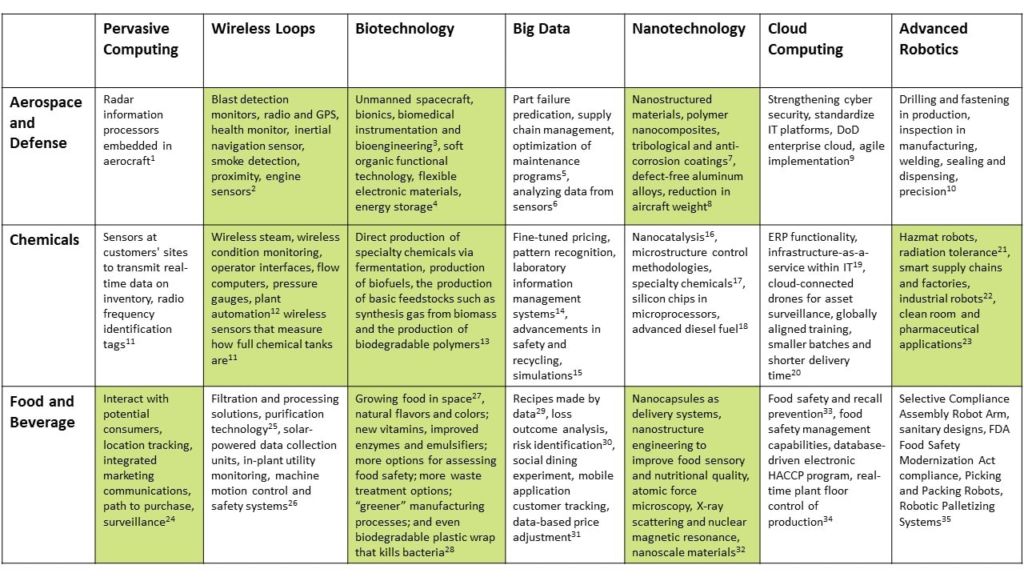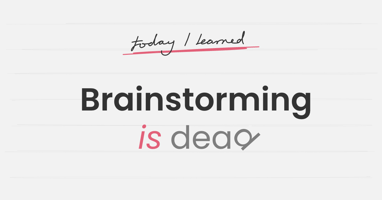This is the second and final post in a two-part series. Read part one:
Accolade Supports Firms in their Quest to be Sustainable Enterprises – A Chemical Industry Example.
In our first article in the series, we discussed how one client is using Sopheon's Accolade software to help aid in their effort to be a Sustainable Enterprise, defined as an organization that aims to ensure all their products are sustainable and safe for the environment. In this installment, we dive deeper into the world of sustainability by taking a look at the seven technologies that are changing the world. We will first look at what the technologies are and how they impact our customer base, and we will then look into how Accolade itself uses four of these technologies to better serve our customers.
There are several new trends in technology that will have an impact on sustainability, and these impacts will be felt by every industry. There are new chances for innovation and development that were not previously possible. Taking a look at these technologies in detail will provide valuable insight into what could be happening in the near future.
Our firm, Sopheon, provides software solutions for a variety of industries, and our goal is to provide customers with solutions that will support their future innovation needs for new product development (NPD) and other areas. Aside from being knowledgeable about their industry, we can provide them with the best service possible if we understand what future trends are coming in their industry and how they may want to adapt to these future changes.
There are seven main technologies that are changing the world, and these technologies will affect all of our customers. Together, these technologies can promote sustainability, provide better healthcare, and lower the cost and resource use of manufacturing. The following is a diagram of what the seven technologies are. 
The first technology is Pervasive Computing. This technology has to do with the mobile devices that we have become so accustomed to. The technology in this group, including cell phones, focuses on all embedded, unobtrusive, everyday devices that are small, powerful, fast, and interconnected. Related to this technology is the second type of new technology, which is Wireless Loops. Wireless Loops manage the transfer of files between people. In addition, they are used to gather sensor data. These loops have a limited range of coverage, but they have an extremely high bandwidth.
Two other technologies that are closely related are Big Data and Cloud Computing. New and innovative solutions often combine the two. Big Data is a collection of data sets so large and complex that they cannot be managed with traditional storage techniques. Companies are gathering all sorts of information and they need to be able to analyze it effectively in order to make informed decisions about their business. Cloud Computing comes into play here because it is one option for managing that information. Cloud Computing provides us with the ability to harness collective power, storage, and connectivity of multiple devices. Thus, storage capabilities are no longer tied to a particular device.
When we move away from computers and more into the realm of science, there are two technologies that are making moves in that space. These technologies are Nanotechnology and Biotechnology. Biotechnology combines the application of physics, biology, and technology to create potential for greater health and well-being of people. This includes advancements such as stem cell research and food sciences. Also related to physics and biology is Nanotechnology, which is the science of creating new materials with specific properties. These materials take cues from biomimicry and then go beyond that to include properties that are beyond what occurs in nature.
The final technology is Advanced Robotics. Robotics has already begun to take form as a field, but Advanced Robotics goes beyond that to the development of robotics that are safer, more intuitive, and anthropomorphic. These new advancements in robotics allow for more precise manufacturing and energy savings.
With an understanding of the basic concepts of these seven technologies, we can now look at some specific examples of how these technologies are affecting the industries that our customers operate in. The focus of this search was for “up and coming” innovations and opportunities in the industries that we work in often. These industries are Aerospace and Defense, Chemicals, and Food and Beverage. The following is a chart that details the main opportunities and new innovations in these industries.

There are many examples in each industry as to how the seven technologies will have an effect in the future and increase how sustainable a company can be. Even though there are examples in each cell in the table, the cells in green indicate the technologies that represent a significant trend in that industry. Even though there are three main trends in each industry, it is important to note that this does not mean that the other technologies are not relevant. For example, each industry will benefit from Big Data and Cloud Computing, but they do not represent trends that could have a significant impact on the future of these industries.
The first industry that houses many of our clients is Aerospace and Defense. In that industry, the technologies that represent significant trends are Wireless Loops, Biotechnology, and Nanotechnology. Many of the potential opportunities in these areas center on the mobility of aircraft and the protection of soldiers. Wireless Loops allow for increased monitoring of health indicators for soldiers and the ability to prevent injury. Both Biotechnology and Nanotechnology can also protect soldiers through the development of materials that further protect soldiers in combat, in addition to advancing aircraft so that they are stealthier and more efficiently use energy sources.
When it comes to the Chemical industry, the three significant technologies are Wireless Loops, Biotechnology, and Advanced Robotics. The Chemical industry is already fairly connected to biology through the development of materials, and Biotechnology presents the potential for significant advancement in this area. Wireless Loops and Advanced Robotics come into play specifically in the chemical production and manufacturing process. Many chemicals are produced in hazardous environments. Wireless Loops allow for safety monitoring and response, and robots can complete tasks that were once unsafe or hazardous for humans to perform.
In the Food and Beverage industry, both Nanotechnology and Biotechnology are significantly important when it comes to health and wellness. There is great potential for innovations that advance food forward to ensure the health of our ever-growing population. Key nutrients and vitamins can be developed to improve food nutrition while new packaging and wrapping help prevent bacteria growth. In addition, Nanotechnology allows for greater understanding of the food and beverages we put into our bodies. As far as Pervasive Computing goes, companies will be able to gain a better understanding of their customers and target marketing in supermarkets to consumer trends.
One final important comment on this table is that Biotechnology shows up as a significant trend in all three industries highlighted. This shows us that we should pay particular attention to opportunities and innovation in this area. In each industry, Biotechnology provides for opportunities to protect our environment and ensure the sustainability of both our environment and our people. We can keep people healthier, longer, while making the world around them safer and more livable.
In addition to our clients seeing advances in their industries from these seven technologies, Sopheon is also using some of these technologies to advance Accolade. There are several technologies that are showing up as significant trends in software, and Accolade incorporates these trends in order to provide a powerful and sustainable system to its users. The three technologies that Accolade builds on are Pervasive Computing, Cloud Computing, and Big Data.
Pervasive Computing, as mentioned above, is most highly related to mobile devices. Accolade Go, Sopheon's mobile platform, allows users to accelerate innovation and new product development by completing work-related tasks from anywhere. Users have the capability to make better, faster decisions on the go. Stakeholders can access project, program, brand, and portfolio information on the go, on any device. View and track corporate innovation activity, review project status, and participate in decisions while traveling or out of the office.
The second technology, Cloud Computing, is also a central initiative at Sopheon. Accolade Cloud allows users to gain the complete power and functionality of Accolade with increased speed to value. Flexible purchasing and deployment options give you the ability to choose the options that best meet your infrastructure and financial needs, so you can be up and running with Accolade quickly, securely, and cost-effectively. You don't have to compromise or buy a lightweight solution to innovate in the cloud. With Accolade Cloud you get the complete functionality of the market-leading, on-premises innovation management software with the faster deployment and convenient management of a cloud solution.
Lastly, the power and scope of innovation analytics and new product development (NPD) analytics has greatly expanded with the advent of Big Data, which is a collection of structured and unstructured data from multiple sources inside and outside your company that is used for discovery and analysis. As the amount of data inside organizations grows and more data becomes available from external sources, Big Data and analytics will become a key basis for your innovation and competitive success. Using internal charts and reports and portfolio-based layouts, users are served up personalized, visual dashboards that are both descriptive and predictive.
References
1http://ieeexplore.ieee.org/document/5635508/
2http://www.analog.com/media/en/technical-documentation/technical-articles/Wirelessly-Linking-the-Aerospace-and-Defense-World.pdf
3http://oai.dtic.mil/oai/oai?verb=getRecord&metadataPrefix=html&identifier=ADA177875
4http://www.militaryaerospace.com/articles/2015/09/energy-storage-Biotechnology.html
5https://www.asme.org/engineering-topics/articles/design/aerospace-bets-on-big-data
6http://aerospaceengineeringblog.com/big-data-in-aerospace/
7http://www.azonano.com/article.aspx?ArticleID=3103
8https://www.asme.org/engineering-topics/articles/Nanotechnology/greener-aerospace-with-Nanotechnology
9https://www.forbes.com/sites/louiscolumbus/2013/08/15/ten-ways-cloud-computing-is-revolutionizing-aerospace-and-defense/#1256a53877b7
10http://blog.robotiq.com/bid/70043/Top-5-Robotic-Applications-in-the-Aerospace-Industry
11http://www.robotics.org/content-detail.cfm/Industrial-Robotics-Industry-Insights/Chemical-and-Hazardous-Material-Handling-Robotics/content_id/614
12http://www.businesswire.com/news/home/20160322006123/en/Global-Industrial-Robots-Chemical-Rubber-Plastics-Industry
13https://www.robots.com/blog/viewing/industrial-robots-and-the-pharmaceutical-industry
14http://www.nanowerk.com/spotlight/spotid=18846.php
15https://link.springer.com/article/10.1023%2FB%3ANANO.0000006151.03088.cb?LI=true
16http://www.essentialchemicalindustry.org/materials-and-applications/nanomaterials.html
17https://www.accenture.com/us-en/insight-trends-chemicals-cloud-use-chemical-companies
18http://www.sganalytics.com/blog/cloud-computing-chemical-industry/
19https://home.kpmg.com/xx/en/home/insights/2016/07/big-data-means-big-opportunities-chemical-companies.html
20https://www.siemens.com/customer-magazine/en/home/industry/big-data-opportunities-for-the-chemical-industry.html
21http://www.essentialchemicalindustry.org/materials-and-applications/Biotechnology-in-the-chemical-industry.html
22http://www.chemicalprocessing.com/category/wireless_technology/
23http://www.zdnet.com/article/pervasive-computing-new-image-new-life/
24http://www.bmsg.org/resources/publications/investigating-digital-path-purchase-food-and-beverages-research-agenda-modern
25http://www.3m.com/3M/en_US/food-beverage-us/
26http://www.foodprocessing.com/articles/2015/wireless-food-and-beverage-plants-on-the-horizon/




